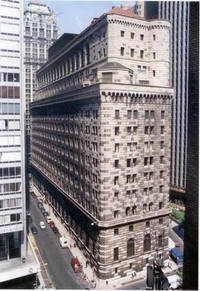Federal Reserve tries to keep U.S. out of recession by cutting key interest rate
Trying to save America from recession, the Federal Reserve cut a key interest rate by one-quarter of a percentage point Tuesday.

The reduction in the federal funds rate to 4.25 percent marked the third rate cut in the past three months. Fed officials signaled that further cuts were possible if a severe downturn in housing and a crisis in mortgage lending get worse.
Commercial banks were expected to quickly match the latest reduction by trimming their prime lending rate, which would reduce this benchmark rate for millions of consumer and business loans to 7.25 percent.
In addition to cutting the funds rate, the Fed announced it was reducing its discount rate, the interest it charges to make direct loans to banks, by a quarter-point as well to 4.75 percent. This reduction was aimed at encouraging banks to borrow more freely from the Fed at a time when there are worries that a rising number of bad loans will prompt banks to tighten credit conditions too severely, adding another strain on the already fragile economy.
The Fed embarked on this round of rate cuts in September in response to severe turbulence in credit markets around the globe as investors reacted to various reports of mounting losses from defaults in subprime mortgages, the latest fallout from the worst slump in the U.S. housing market in more than two decades.
After cutting the funds rate by a half-point on Sept. 11 and a quarter-point on Oct. 31, the central bank indicated that those two reductions might be all that were needed to combat the threat of a recession given that financial markets appeared to be stabilizing.
However, increased market turbulence following the October meeting and growing fears of a recession caused the Fed to do an about-face.
In a brief statement explaining its action, the Fed said that recent economic data indicated that the economy is slowing, "reflecting the intensification of the housing correction and some softening in business and consumer spending."
The Fed also noted that "strains in financial markets have increased in recent weeks."
In its Oct. 31 statement, the Fed said it viewed the risks from weak growth as roughly balanced with the risks of higher inflation.
However, that phrase was changed in the current statement to read, "Recent developments, including the deterioration in financial market conditions, have increased the uncertainty surrounding the outlook for economic growth and inflation."
The Fed vote for the rate cut was 9 to 1 with Eric S. Rosengren dissenting, arguing for a bigger, half-point cut in the funds rate.
Many economists believe the housing slump and credit turmoil have raised the risks of a recession. Many analysts believe that economic growth, as measured by the gross domestic product, may have dipped to a barely perceptible 1 percent rate, raising the chance that some shock, such as another surge in energy prices, could push the U.S. into a recession.
But many analysts still believe the Fed will be able to respond forcefully enough with rate cuts that it will keep the current expansion alive. These analysts believe that the economy will start to rebound to faster growth by the middle of next year, when they expect that lower mortgage rates will have spurred a rebound in home sales.
"I think a full blown recession can be avoided but just barely," said David Jones, chief economist at DMJ Advisors. He predicted that the Fed will follow up its December rate cut with three more reductions at its first three meetings of 2008.
Subscribe to Pravda.Ru Telegram channel, Facebook, RSS!




